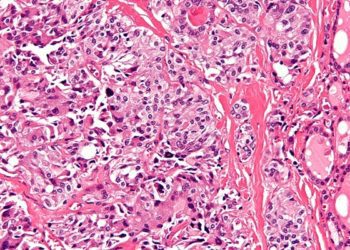Guideline-concordant multimodal therapy associated with improved mortality outcomes in patients with high-risk prostate cancer
1. Among patients with high-risk prostate cancer receiving guideline-concordant multimodal therapy, prostate cancer-specific mortality outcomes were equivalent among radical prostatectomy, external beam radiotherapy alone, and external beam radiotherapy plus brachytherapy.
2. Novel treatment and research strategies should be focused on minimizing distant metastasis in patients with high-risk prostate cancer, particularly in individuals pursuing radical prostatectomy as definitive treatment.
Evidence Rating Level: 2 (Good)
Study Rundown: The treatment of high-risk localized prostate cancer has improved significantly over recent years to include definitive treatment with radiotherapy or radical prostatectomy (RP). Options for definitive radiotherapy include external beam radiotherapy (EBRT) alone and EBRT with a brachytherapy boost (BT), both delivered with androgen deprivation therapy (ADT), while definitive RP can incorporate a variety of postoperative treatments. Despite having these options, the optimal treatment for high-risk prostate cancer remains unclear, with sparse prospective data and several retrospective series involving patients treated over the course of their disease using outdated strategies discordant with current clinical guidelines. This retrospective cohort study sought to comprehensively evaluate the associations between prostate cancer-specific mortality, distant metastasis, and the three standard treatments for high-risk prostate cancer while also accounting for clinical heterogeneity and delivery of guideline-concordant multimodality care. Guideline-concordant multimodal treatment was defined as RP with appropriate use of multimodal therapy (optimal RP), EBRT with at least 2 years of ADT (optimal EBRT), or EBRT with BT with at least 1 year ADT (optimal EBRT with BT). The main outcome and measure of the analysis was prostate cancer-specific mortality with distant metastasis as a secondary endpoint. Among 6,004 men enrolled with high-risk prostate cancer and at least 1 additional adverse clinicopathologic feature, no differences in prostate cancer-specific mortality were observed across treatment modalities, although differences in time to metastasis were apparent. However, significant differences in prostate cancer-specific mortality were identified when guideline-concordant multimodality care was not delivered. These results suggest that among patients with high-risk prostate cancer receiving guideline-concordant multimodal therapy, prostate cancer-specific mortality outcomes were equivalent among RP, EBRT alone, and EBRT plus BT. Thus, treatment and research strategies should be focused on minimizing distant metastasis, particularly in patients pursuing RP as definitive treatment. A limitation of this study lies in the retrospective nature of the design and the inherent biases and confounding that comes with the data compilation and analysis processes. The analysis attempted to minimize these biases using statistical means but were unable to eliminate the significant selection biases, detection biases, and ecological biases that would impact any multicenter retrospective study comparing treatment efficacies. Thus, prospective data is needed in future studies to fully validate these retrospective findings.
Click to read the study in JAMA Network Open
Relevant Reading: Long-term survival after radical prostatectomy versus external-beam radiotherapy for patients with high-risk prostate cancer
In-Depth [retrospective cohort]: This retrospective cohort study included 6,004 men (median [IQR] age, 66.4 [60.9-71.8] years) with high-risk prostate cancer treated between 2000 and 2014 at 16 tertiary centers, including 3,175 patients (52.9%) who underwent RP, 1,830 patients (30.5%) who underwent EBRT alone, and 999 patients (16.6%) who underwent EBRT with BT. Inclusion criteria included patients with high-risk prostate cancer (as defined by the National Comprehensive Cancer Network [NCCN]) and at least 1 adverse clinicopathologic feature (defined as any primary Gleason pattern 5 on biopsy, clinical T3b-4 disease, ≥50% cores with biopsy results positive for prostate cancer, or NCCN ≥2 high-risk features). Compared to RP alone, EBRT plus BT treatment (subdistribution hazard ratio [sHR] 0.78, [95% CI, 0.63-0.97]; P = .03) or EBRT alone (sHR, 0.70 [95%CI, 0.53-0.92]; P = .01) were associated with significantly improved prostate cancer-specific mortality, although there was no significant difference in prostate cancer-specific mortality between EBRT plus BT and EBRT alone (sHR, 0.89 [95%CI, 0.67-1.18]; P = .43). Furthermore, no significant differences in prostate cancer-specific mortality were found across treatment cohorts among 2,940 patients who received guideline-concordant multimodality treatment (e.g., optimal EBRT alone vs optimal RP: sHR, 0.76 [95%CI, 0.52-1.09]; P = .14). However, treatment with EBRT alone or EBRT plus BT was consistently associated with lower rates of distant metastasis compared with RP treatment alone (e.g., EBRT vs RP: sHR, 0.50 [95%CI, 0.44-0.58]; P < .001).
Image: PD
©2021 2 Minute Medicine, Inc. All rights reserved. No works may be reproduced without expressed written consent from 2 Minute Medicine, Inc. Inquire about licensing here. No article should be construed as medical advice and is not intended as such by the authors or by 2 Minute Medicine, Inc.




![2 Minute Medicine: Pharma Roundup: Price Hikes, Breakthrough Approvals, Legal Showdowns, Biotech Expansion, and Europe’s Pricing Debate [May 12nd, 2025]](https://www.2minutemedicine.com/wp-content/uploads/2025/05/ChatGPT-Image-May-12-2025-at-10_22_23-AM-350x250.png)




